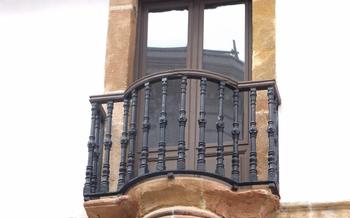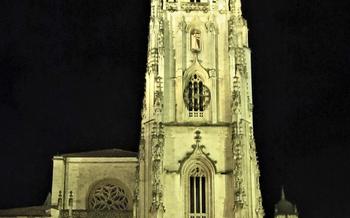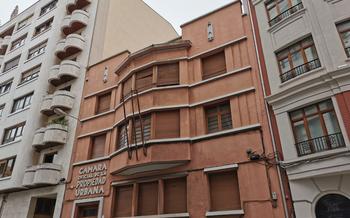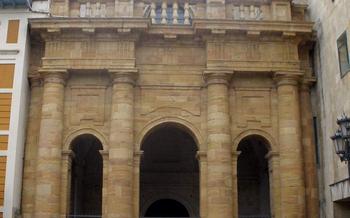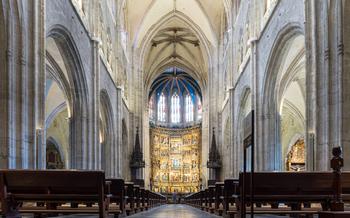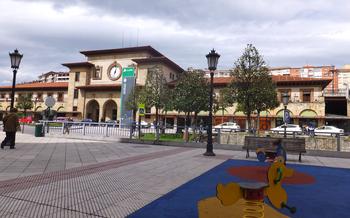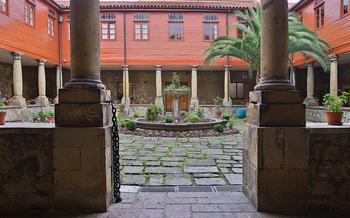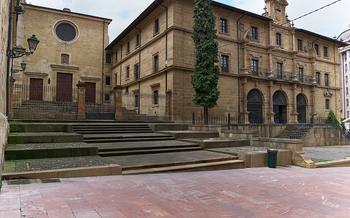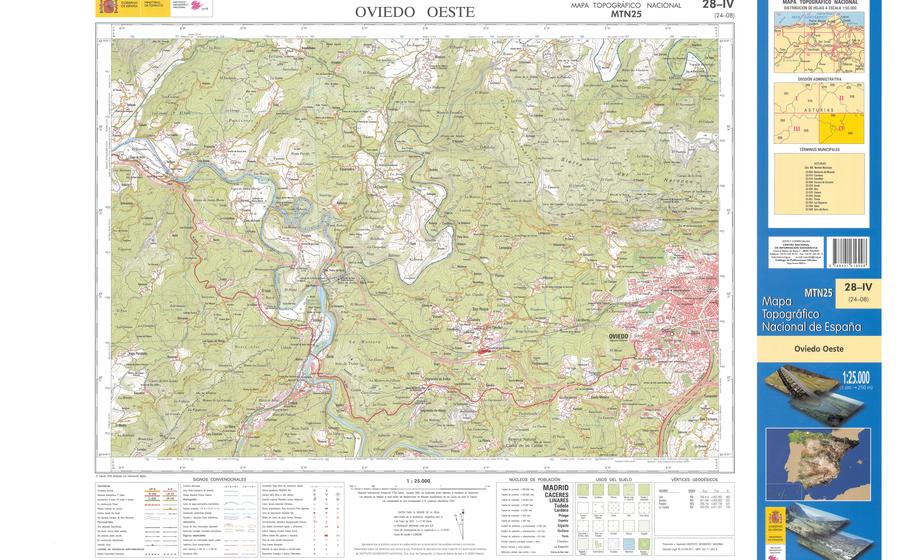
Barrio Histórico de Cimadevilla
- The Rebirth of Cimadevilla
- Walking the Calle San Francisco
- Church of San Francisco
- Plaza del Ayuntamiento
- The City Walls
- Plaza de Trascorrales: A Lively Social and Commercial Hub
- Palacio de los Valdecarzana: A Renaissance Masterpiece
- Campoamor Theatre
- Plaza de la Catedral
- Oviedo Cathedral
- Museo de Bellas Artes de Asturias: A Treasure Trove of Artistic Masterpieces
- Camino Primitivo
- Local Cuisine
- Insider Tip
The Rebirth of Cimadevilla
Once a humble fishing village, Cimadevilla has undergone a remarkable transformation into a vibrant urban center. This rebirth can be traced to several key events and figures. In the 19th century, the construction of the port and the arrival of the railway brought new economic opportunities to the neighborhood. The establishment of the University of Oviedo in the same period attracted students and intellectuals, contributing to Cimadevilla's cultural revival.
The neighborhood's architectural landscape reflects this evolution. Traditional fishermen's cottages now stand alongside elegant mansions and modern buildings, creating a harmonious blend of old and new. Cultural influences from various periods have further enriched Cimadevilla's streetscape. Romanesque, Gothic, Renaissance, and Baroque elements can be found in its churches, palaces, and public buildings.
This transformation reflects the changing face of Oviedo itself. Once a small provincial town, Oviedo has grown into a modern and cosmopolitan city while retaining its rich historical heritage. Cimadevilla, as its historic heart, embodies this transformation, serving as a reminder of the city's humble origins and its journey towards becoming a vibrant and modern urban center.
Walking the Calle San Francisco
The Calle San Francisco, the main artery of Cimadevilla, beckons with its vibrant energy and architectural charm. Strolling along this historic street, visitors are greeted by an array of architectural wonders, from stately palaces to historic buildings, each narrating a chapter of Cimadevilla's rich past.
Among these architectural gems, the Palacio de los Marqueses de San Feliz stands out with its elegant facade adorned with intricate carvings. Just a few steps away, the Casa de los Campomanes, with its Renaissance-style windows and balconies, transports visitors to a bygone era.
The street is not just about architectural marvels; it is also a hub of local life. Charming cafes, inviting restaurants, and unique shops line the Calle San Francisco, creating a lively atmosphere. The air is filled with the aroma of freshly brewed coffee, the chatter of locals, and the clinking of glasses from nearby sidrerías.
As you wander further down the street, take notice of the streetlamps, each adorned with a distinct design. These artistic creations add a touch of whimsy to the Calle San Francisco, making it a delightful place to stroll both day and night.
The Calle San Francisco is not just a street; it is the very essence of Cimadevilla, a testament to its rich history and vibrant present. Whether you are a history buff, an architecture enthusiast, or simply a curious traveler, this historic thoroughfare promises an unforgettable experience.
Church of San Francisco
In the heart of Oviedo's historic Cimadevilla neighborhood stands the Church of San Francisco, a testament to the enduring legacy of Gothic architecture in Asturias. Its intricate stone facade, featuring delicate carvings and graceful arches, hints at the artistic and spiritual treasures within.
Step inside to be greeted by a soaring vaulted ceiling, supported by slender columns that create a sense of awe and tranquility. The church's most striking feature is its magnificent altarpiece, a masterpiece of Gothic craftsmanship. Intricately carved scenes from the life of Christ and the saints adorn its panels, each detail rendered with exquisite precision.
The stained glass windows, casting a kaleidoscope of colors onto the interior, add to the church's ethereal atmosphere. Bathed in the soft hues of reds, blues, and greens, the church's interior comes alive, creating a mystical ambiance that invites contemplation and reverence.
Beyond its artistic splendor, the Church of San Francisco holds a significant place in Cimadevilla's religious and cultural heritage. Built in the 13th century, it has witnessed countless baptisms, marriages, and funerals, serving as a cornerstone of the community's spiritual life.
Over the centuries, the church has been lovingly maintained and restored, preserving its original charm while adapting to the changing needs of the congregation. Today, it remains a vibrant house of worship, hosting regular masses, special events, and concerts, bringing together the community in celebration and prayer.
Amidst the hustle and bustle of modern Oviedo, the Church of San Francisco stands as an oasis of serenity, offering a glimpse into the city's rich past and inviting visitors to connect with the sacred and the sublime.
Plaza del Ayuntamiento
Plaza del Ayuntamiento, the historic square where Oviedo's city hall proudly stands, beckons with its architectural allure and historical significance. The square's centerpiece, the Town Hall building, captivates with its ornate facade, intricate carvings, and clock tower that punctuates the skyline. Inside, visitors can marvel at the grand staircase, elegant reception halls, and historic council chambers, where the city's decisions have been shaped for centuries.
Beyond the Town Hall, Plaza del Ayuntamiento unveils a tapestry of architectural wonders. The square is flanked by stately buildings, each with its unique story to tell. The Palacio de la Rúa, with its Renaissance-style facade adorned with elaborate balconies, stands as a testament to the city's artistic heritage. The Casa Consistorial, with its Gothic windows and imposing presence, evokes the grandeur of Oviedo's past.
As a stage for local life, Plaza del Ayuntamiento buzzes with activity. Markets, festivals, and cultural events fill the air with excitement, drawing locals and visitors alike. Whether it's the bustling Christmas market, the vibrant summer concerts, or the traditional Asturian festivities, the square transforms into a vibrant hub of community spirit and celebration.
Step into Plaza del Ayuntamiento and immerse yourself in Oviedo's rich history, architectural charm, and vibrant local culture. From the grandeur of the Town Hall to the lively atmosphere of its events, this square epitomizes the essence of the city's spirit.
The City Walls
The ancient city walls of Oviedo, dating back to the 13th century, stand as a testament to the city's rich history and resilience. These imposing fortifications once served as a protective barrier against invaders, encircling the city and safeguarding its inhabitants. Today, these walls have been transformed into a captivating promenade, offering visitors a unique perspective on Oviedo's past and present.
Strolling along the top of the walls, you'll be greeted by breathtaking panoramic vistas of the city. The spires of the city's many churches and cathedrals pierce the skyline, while the lush green hills that cradle Oviedo provide a stunning backdrop. As you walk, you'll encounter several well-preserved gates and towers, including the Puerta de la Noceda, which once served as the main entrance to the city.
These walls not only protected Oviedo from physical threats but also played a crucial role in shaping the city's identity and development. They defined the boundaries of the city, influenced its urban planning, and served as a symbol of its autonomy and independence. Today, the walls have been seamlessly integrated into modern urban life, serving as a popular promenade for locals and tourists alike.
Plaza de Trascorrales: A Lively Social and Commercial Hub
In the heart of Cimadevilla, nestled amidst narrow streets and historic buildings, lies the vibrant Plaza de Trascorrales. This charming square exudes a lively atmosphere, serving as a social and commercial hub for both locals and visitors.
The plaza's architectural features are a testament to its rich history. Colorful buildings with intricate facades surround the square, creating a visually captivating scene. Arcades line the perimeter, offering shelter from the sun or rain while allowing visitors to admire the surrounding architecture.
The square is a hub of activity throughout the day. Local markets set up their stalls, selling fresh produce, artisanal crafts, and souvenirs. Shoppers can browse the unique offerings of the boutiques and specialty stores that line the plaza.
When hunger strikes, visitors can indulge in the culinary delights offered by the many restaurants and cafes that surround Plaza de Trascorrales. From traditional Asturian dishes to international cuisine, there's something to satisfy every palate.
In the evenings, the square transforms into a lively social scene. Locals and tourists gather at the outdoor tables of the bars and restaurants, enjoying drinks, tapas, and lively conversation. The square's vibrant atmosphere is infectious, making it the perfect place to soak up the local culture and make new friends.
Plaza de Trascorrales is a must-visit destination for anyone exploring Cimadevilla. Its unique blend of history, architecture, and lively atmosphere makes it a place where visitors can truly immerse themselves in the heart of this vibrant neighborhood.
Palacio de los Valdecarzana: A Renaissance Masterpiece
In the heart of Cimadevilla stands the majestic Palacio de los Valdecarzana, a testament to the neighborhood's rich architectural heritage. This Renaissance-style palace, built in the 16th century, is a captivating blend of elegance and opulence. Its intricate facade, adorned with intricate carvings and decorative elements, hints at the grandeur that awaits within.
Step inside the palace and be transported back in time as you explore its stunning interior. The grand staircase, with its elaborate balustrade, leads to a series of opulent rooms, each adorned with unique features. The intricately painted ceilings, adorned with mythological scenes and biblical motifs, are a testament to the artistic prowess of the era.
Marvel at the grand ballroom, where lavish parties and social gatherings were once held. Its polished wooden floors, crystal chandeliers, and ornate mirrors create an atmosphere of timeless elegance. The palace also boasts a beautiful patio, a tranquil oasis adorned with fountains, colorful tiles, and lush greenery.
The history of the palace is closely intertwined with the Valdecarzana family, one of Oviedo's most prominent and influential families. They commissioned the construction of the palace as a symbol of their wealth and power. Throughout the centuries, the palace has witnessed countless events, from lavish celebrations to political gatherings, leaving an indelible mark on Oviedo's history.
Today, the Palacio de los Valdecarzana serves as a cultural center and exhibition space, hosting a variety of events, including art exhibitions, conferences, and concerts. Visitors can explore the palace's grand halls, admire its exquisite architecture, and learn about its fascinating history, making it a must-visit destination for anyone interested in Oviedo's rich cultural heritage.
Campoamor Theatre
The Campoamor Theatre, named after the renowned Asturian poet Ramón de Campoamor, is a majestic cultural landmark in Cimadevilla. Completed in 1892, this iconic theater stands as a testament to Oviedo's rich artistic heritage. Its grand facade, featuring intricate carvings and sculptures, hints at the theatrical wonders that await within.
Stepping inside the Campoamor Theatre is like stepping back in time. The auditorium, adorned with plush red velvet seats and gleaming chandeliers, exudes an aura of opulence and elegance. The stage, framed by an ornate proscenium arch, has witnessed countless performances that have captivated audiences for over a century.
The Campoamor Theatre has hosted a diverse range of performances throughout its illustrious history, from classical dramas to contemporary plays, zarzuelas to concerts. It has been the stage for legendary artists, including Spanish Golden Age playwrights, renowned opera singers, and international ballet companies.
Beyond its role as a performance venue, the Campoamor Theatre is also a hub for cultural events and exhibitions. It hosts film screenings, art shows, conferences, and educational programs, contributing to the vibrant cultural landscape of Oviedo.
For those seeking a truly immersive cultural experience in Cimadevilla, attending a performance at the Campoamor Theatre is a must. Whether it's a captivating play, a soul-stirring concert, or a mesmerizing dance performance, the Campoamor Theatre promises an unforgettable evening of entertainment and artistic excellence.
Plaza de la Catedral
The Plaza de la Catedral is the heart of Oviedo's religious and cultural life. Dominated by the majestic Cathedral of San Salvador, the square is a harmonious blend of architectural styles, historical significance, and sacred traditions.
In the center of the square stands the cathedral, a Gothic masterpiece with a towering spire that pierces the Asturian sky. The intricate facade, adorned with sculptures and carvings, narrates biblical tales and the history of the diocese. Inside, visitors are awestruck by the vaulted ceilings, stained glass windows that bathe the interior in colorful light, and the elaborately carved choir stalls.
The Plaza de la Catedral is not just a place of worship but also a stage for cultural and historical events. Throughout the year, the square hosts religious processions, music concerts, art exhibitions, and traditional festivals. The San Mateo Festival, held in September, transforms the square into a vibrant hub of music, dance, and culinary delights.
As you wander through the Plaza de la Catedral, take a moment to soak in the atmosphere, admire the architectural details, and feel the centuries of history that permeate this sacred space.
Oviedo Cathedral
The heart of Oviedo's religious and cultural life beats within the walls of its awe-inspiring cathedral, a Gothic masterpiece that has stood as a symbol of faith and architectural prowess for centuries. As you approach this magnificent edifice, its distinctive spire, reaching towards the heavens, commands your attention. Once inside, prepare to be captivated by the cathedral's soaring arches, intricate stained glass windows, and the serene beauty of its cloister.
Take your time to explore the cathedral's interior, where each detail whispers tales of its rich history. Gaze upon the stunning altarpiece, a masterpiece of religious art, and let the vibrant colors of the stained glass windows transport you to a realm of divine light. In the cathedral's museum, discover a treasure trove of religious artifacts, paintings, and sculptures that narrate the story of Oviedo's deep-rooted faith.
Legends and fascinating stories surround Oviedo Cathedral, adding to its mystique. One tale speaks of a hidden chamber beneath the cathedral, rumored to contain a vast library of ancient texts and secrets. As you wander through the cathedral's hallowed halls, let your imagination wander, and perhaps you too will uncover a piece of its enchanting lore.
Museo de Bellas Artes de Asturias: A Treasure Trove of Artistic Masterpieces
Housed in a former Benedictine monastery, the Museo de Bellas Artes de Asturias is a haven for art enthusiasts. Its collection spans from the medieval era to the contemporary period, showcasing masterpieces by Spanish masters like El Greco, Goya, and Dalí, as well as international artists such as Rubens and Van Dyck.
Visitors can wander through the museum's galleries, admiring religious paintings, portraits, landscapes, and sculptures. The collection is particularly strong in Asturian art, providing a comprehensive overview of the region's artistic heritage.
The museum also hosts temporary exhibitions, educational programs, and workshops, making it a dynamic and engaging cultural space. Whether you're an art aficionado or simply looking to appreciate the beauty of artistic expression, the Museo de Bellas Artes de Asturias is a must-visit destination in Oviedo.
Camino Primitivo
The Camino Primitivo is an ancient pilgrimage route that begins in Oviedo and is considered to be the original camino to Santiago de Compostela. This historic route dates back to the 9th century when King Alfonso II of Asturias was guided by a star to the tomb of Saint James the Apostle. Pilgrims on the Camino Primitivo follow in the footsteps of King Alfonso, journeying through stunning landscapes, medieval villages, and historic churches.
Along the way, pilgrims can experience the rich cultural heritage of Asturias, including its traditional music, art, and cuisine. The route is well-marked and offers a variety of accommodation options, from traditional albergues to charming guesthouses. Whether you are a seasoned pilgrim or a first-time walker, the Camino Primitivo offers a unique and rewarding experience.
Highlights of the Camino Primitivo
-
Historic cities and villages: The route passes through several historic cities and villages, including Oviedo, Grado, Salas, and Tineo. Pilgrims can explore medieval churches, castles, and other historic landmarks along the way.
-
Stunning landscapes: The Camino Primitivo traverses a variety of landscapes, from lush forests to rolling hills and mountain passes. Pilgrims can enjoy breathtaking views of the Asturian countryside, including the Picos de Europa mountain range.
-
Cultural experiences: The route offers a chance to experience the rich cultural heritage of Asturias. Pilgrims can visit traditional villages, sample local cuisine, and attend local festivals and events.
-
Spiritual significance: The Camino Primitivo is an important pilgrimage route for Christians, and pilgrims can experience a deep sense of spirituality as they journey to the tomb of Saint James.
Tips for Pilgrims
-
Plan your trip: Plan your itinerary in advance, especially if you are walking during the peak season. Book your accommodation in advance, and make sure to carry a map and guidebook.
-
Pack light: Pack light, as you will be carrying your belongings on your back. Bring comfortable shoes, a raincoat, and a hat.
-
Be prepared for weather: The weather in Asturias can be unpredictable, so be prepared for rain, sun, and wind.
-
Take your time: The Camino Primitivo is a journey, not a race. Take your time to enjoy the scenery, meet other pilgrims, and experience the local culture.
Local Cuisine
Cimadevilla and Oviedo are renowned for their diverse and delectable cuisine, showcasing the culinary delights of the Asturias region. One must-try dish is fabada Asturiana, a hearty bean stew with sausage, pork, and vegetables. The cachopo, a breaded and fried veal cutlet filled with cheese and ham, is another local favorite. For seafood enthusiasts, pulpo a la gallega (octopus) and mariscada (seafood platter) are highly recommended.
To fully experience Asturian gastronomy, visit the local markets, such as Mercado de El Fontán, to purchase fresh ingredients and sample traditional dishes. Don't miss the chance to try local cheeses, including Cabrales and Afuega'l Pitu, as well as the region's famous sidra (cider).
For a unique dining experience, try one of the many sidrerías (cider bars) in Cimadevilla and Oviedo. These establishments offer a casual atmosphere and serve traditional Asturian dishes paired with freshly poured sidra.
To fully immerse yourself in the local food culture, consider taking a cooking class or joining a food tour. These experiences allow you to learn about the history and preparation of Asturian cuisine while sampling various dishes and drinks.
Remember, when dining in Oviedo, don't be afraid to try new things and ask for recommendations from locals or your hotel concierge. Embracing the local gastronomy is an essential part of experiencing the vibrant culture of Cimadevilla and Oviedo.
Insider Tip
Beyond the main attractions, Cimadevilla holds hidden gems waiting to be discovered. Explore tranquil courtyards, each with its unique charm, offering respite from the lively streets. Seek out viewpoints that provide breathtaking panoramas of the city and the surrounding mountains. Immerse yourself in local festivities, such as the colorful "Descensu del Nalón" boat race or the lively "Festival de la Sidra," which celebrates the region's beloved cider.
Discover unique shops and craft workshops tucked away in the neighborhood's charming alleys. Browse handmade pottery, intricate jewelry, and traditional Asturian textiles. Support local artisans by purchasing their creations as souvenirs or gifts. Join a guided tour or walking tour to gain deeper insights into Cimadevilla's rich history and culture. Learn about the neighborhood's past as a fishing village, its architectural evolution, and the stories of its people. Capture the essence of Cimadevilla through photography. Immortalize the picturesque streets, colorful facades, and vibrant atmosphere that make this neighborhood so captivating.
